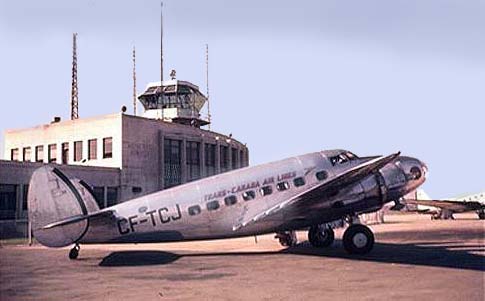- Lockheed L-14 Super Electra
Infobox Aircraft
name = L-14 Super Electra
type = Civil cargo and passenger transport
manufacturer =Lockheed Corporation 
caption = Trans Canada Airlines Lockheed 14H2 c. 1938
designer = Don Palmer
first flight = 29 July, 1937
introduced = October 1937
retired =
status =
primary user =
more users =
produced =
number built = 233
unit cost =
variants with their own articles = The Lockheed Model 14 Super Electra was a civil cargo and passengeraircraft built by the Lockheed Aircraft Corporation during the late 1930s.Design and development
The design was a scaled-up version of the original Electra; the design team was lead by Don Palmer. The first Model 14 flew on July 29, 1937, piloted by
Marshall Headle . Lockheed built a total of 114 Model 14s; another 119 were built under license inJapan by the Tachikawa Aircraft Company under the designation Tachikawa Type LO "Thelma".Operational history
The Model 14 entered commercial service with
Northwest Airlines in October 1937. Aircraft were exported for use byAer Lingus ofIreland , BOAC of Britain,Union Airways andNational Airways Corporation (NAC) ofNew Zealand . The Model 14 was the basis for development of theLockheed Hudson maritimereconnaissance andlight bomber aircraft operated by theRoyal Air Force , USAAF,United States Navy and many others during theSecond World War .Record-breaking flights
In May 1938, a team of aviators of the Polish airline LOT, made up of Waclaw Makowski, director of the LOT and first pilot, Zbigniew Wysiekierski, second pilot, Szymon Piskorz, mechanic and radionavigator, Alfons Rzeczewski, radio-navigator and Jerzy Krassowski, assistant, accomplished an experimental flight from the United States to Poland. This flight was carried out on board one of the planes bought by LOT and manufactured by Lockheed in California, Lockheed L-14H Super Electra (of which the Polish registration was SP-LMK [http://www.edcoatescollection.com/ac5/ROW%20Europe/SP-LMK.html] ). The crew took off from Burbank (Los Angeles) where these planes were manufactured, towards Warsaw.
The distance covered was of 24,850 km. They flew over the states of Central America (Mazatlan, Mexico City, Guatemala, Panama), of South America (Lima, Santiago, Buenos Aires, Rio, Natal), the South Atlantic, Africa (Dakar, Casabianca, Tunis), Italy (Roma). The flight lasted 85 hours between May 13 and June 5. The overflight of the Atlantic - from Natal in Brazil to Dakar in Africa - lasted 11 hours and 10 minutes (3,070 km). This exploit of Polish aviators really marked the history of air communication on a world level. [http://www.cegesoma.be/pls/opac/opac.search?lan=N&seop=2&sele=51&sepa=1&doty=&sest=&chna=&senu=68503&rqdb=1&dbnu=1]
Howard Hughes flew a Super Electra (NX18973) on a globalcircumnavigation flight. With four crewmates (Harry Connor, copilot and navigator; Tom Thurlow, navigator; Richard Stoddart, radio operator; and Ed Lund, flight engineer), the plane took off fromFloyd Bennett Field in New York on July 10, 1938. The flight, which circled the narrower northern latitudes, passed throughParis ,Moscow ,Omsk ,Yakutsk ,Fairbanks, Alaska , andMinneapolis , before returning to New York on July 14. The total distance flown was 14,672 mi (23,612 km).Operators
Civilian
*
Aer Lingus
*BOAC
*Continental Airlines
*National Airways Corporation
*Northwest Airlines
*Santa Maria Airlines
*Trans Canada Airlines
*Union Airways
*LOT Polish Airlines (10 in 1938-1940)
*KNILM Military
* :
Royal Canadian Air Force
*
* :South African Air Force
* :US Army Air Force ,United States Navy pecifications (Model 14-WF62 Super Electra)
aircraft specifications
plane or copter?=plane
jet or prop?=prop
ref=
crew=two, pilot and co-pilot
capacity=12 passengers
payload main=
payload alt=
length main= 44 ft 4 in
length alt= 13.52 m
span main= 65 ft 6 in
span alt= 19.97 m
height main= 11 ft 5 in
height alt= 3.48 m
area main= 551 ft²
area alt= 51.2 m²
airfoil=
empty weight main= 10,750 lb
empty weight alt= 4,886 kg
loaded weight main= 15,650 lb
loaded weight alt= 7,114 kg
useful load main=
useful load alt=
max takeoff weight main= 17,500 lb
max takeoff weight alt= 7,955 kg
more general=
engine (prop)= Wright SGR-1820-F62
type of prop=radial engine s
number of props=2
power main= 760 hp
power alt= 567 kW
power original=
max speed main=250mph
max speed alt= 402 km/h
cruise speed main=
cruise speed alt=
stall speed main=
stall speed alt=
never exceed speed main=
never exceed speed alt=
range main= 2,125 mi
range alt=3,420 km
ceiling main= 24,500 ft
ceiling alt= 7,649 m
climb rate main=
climb rate alt=
loading main= 28 lb/ft²
loading alt=139 kg/m²
thrust/weight=
power/mass main=0.10 hp/lb
power/mass alt=0.16 kW/kg
more performance=
armament=
avionics=Accidents and incidents
*
Northwest Airlines Flight 2
*Northwest Airlines Flight 1 ee also
aircontent
related=
*Lockheed Electra
*Lockheed Electra Junior
*Lockheed Hudson
similar aircraft=
sequence=
lists=
*List of military aircraft of the United States
*List of military aircraft of the United States (naval)
*List of Lockheed aircraft
see also=References
* Francillon, René J. "Lockheed Aircraft since 1913." Annapolis: Naval Institute Press, 1987. ISBN 0-85177-835-6.
External links
* [http://www.microworks.net/pacific/aviation/PBO_Hudson.htm Lockheed R4O Super Electra]
Wikimedia Foundation. 2010.
